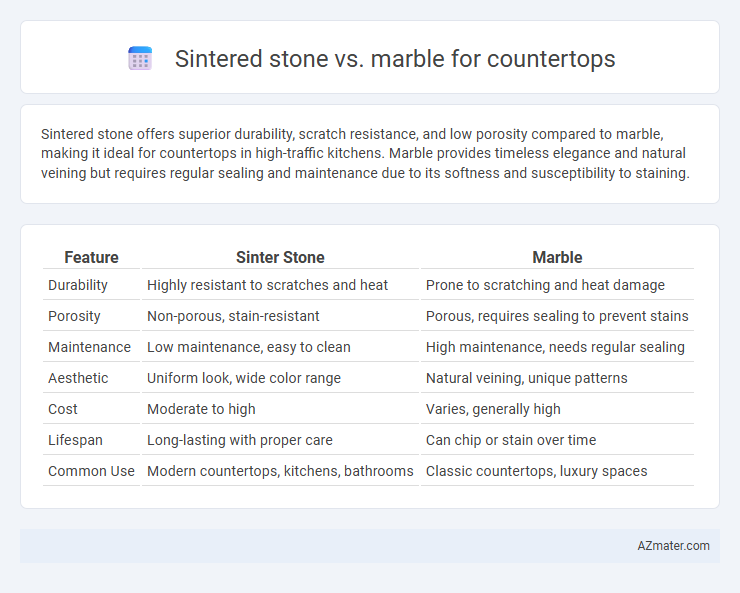Sintered stone offers superior durability, scratch resistance, and low porosity compared to marble, making it ideal for countertops in high-traffic kitchens. Marble provides timeless elegance and natural veining but requires regular sealing and maintenance due to its softness and susceptibility to staining.
Table of Comparison
| Feature | Sinter Stone | Marble |
|---|---|---|
| Durability | Highly resistant to scratches and heat | Prone to scratching and heat damage |
| Porosity | Non-porous, stain-resistant | Porous, requires sealing to prevent stains |
| Maintenance | Low maintenance, easy to clean | High maintenance, needs regular sealing |
| Aesthetic | Uniform look, wide color range | Natural veining, unique patterns |
| Cost | Moderate to high | Varies, generally high |
| Lifespan | Long-lasting with proper care | Can chip or stain over time |
| Common Use | Modern countertops, kitchens, bathrooms | Classic countertops, luxury spaces |
Introduction: Sinter Stone vs Marble Countertops
Sintered stone countertops offer exceptional durability, resistance to scratches, stains, and heat, making them ideal for high-traffic kitchen environments. Marble countertops provide timeless elegance with unique natural veining but require regular sealing to prevent damage from acids and scratches. Choosing between sinter stone and marble depends on balancing aesthetic preference with maintenance and durability needs.
Composition and Material Properties
Sintered stone countertops are composed of compressed natural minerals, primarily quartz, feldspar, and porcelain, offering exceptional hardness and resistance to scratches, heat, and stains. In contrast, marble is a metamorphic rock composed mainly of calcite, which is softer and more porous, making it more prone to etching, staining, and damage from acidic substances. The dense, non-porous structure of sinter stone ensures superior durability and low maintenance compared to the more delicate and porous surface of marble countertops.
Appearance and Design Options
Sintered stone offers a wide range of appearance options, including patterns that closely mimic natural materials like marble while providing enhanced durability and resistance to scratches and stains. Marble features unique, elegant veining and a timeless, luxurious look that varies naturally from slab to slab, making each countertop distinctive. Both materials support various design preferences, but sintered stone allows more consistent patterns and colors for contemporary and versatile styles.
Durability and Strength Comparison
Sintered stone exhibits exceptional durability and resistance to scratches, heat, and stains, making it highly suitable for heavy-use countertops. Marble, while aesthetically luxurious with unique veining, is softer and more porous, making it prone to scratching, etching, and staining over time. For long-lasting strength and minimal maintenance, sintered stone outperforms marble in countertop applications.
Resistance to Stains, Heat, and Scratches
Sintered stone offers superior resistance to stains, heat, and scratches compared to marble, making it an ideal choice for kitchen countertops exposed to daily wear. Unlike marble, which is porous and susceptible to etching from acidic substances and staining, sintered stone is non-porous and highly durable, maintaining its appearance without sealing. Its resistance to high temperatures and abrasions surpasses marble, ensuring longevity and minimal maintenance in high-traffic areas.
Maintenance and Cleaning Requirements
Sintered stone countertops offer superior resistance to stains, scratches, and heat, requiring minimal maintenance compared to marble, which needs regular sealing to prevent etching and discoloration. Cleaning sintered stone is hassle-free using mild soap and water, whereas marble demands gentle, pH-neutral cleaners to avoid damage from acidic substances. The durability and low upkeep of sintered stone make it an ideal choice for busy kitchens, while marble's porous surface requires more vigilant care to preserve its natural beauty.
Environmental Impact and Sustainability
Sinter stone countertops offer superior sustainability due to their low environmental footprint, as they are made from natural minerals using eco-friendly processes with minimal water and energy consumption. Marble extraction involves quarrying that significantly disrupts ecosystems and produces substantial waste, along with higher carbon emissions from transportation and processing. Choosing sinter stone supports eco-conscious construction by reducing resource depletion and promoting durability, while marble's environmental impact is amplified by its limited recyclability and higher maintenance requirements.
Cost and Value for Money
Sintered stone countertops typically cost between $60 and $100 per square foot, offering exceptional durability and resistance to scratches, heat, and stains, thus providing excellent value for money in high-use kitchens. Marble countertops range from $50 to $150 per square foot, prized for their natural beauty but requiring regular maintenance and sealing, which can increase long-term costs. When balancing initial investment and longevity, sintered stone often represents a more cost-effective choice, especially in busy households seeking low upkeep and lasting aesthetic appeal.
Installation Process and Flexibility
Sintered stone countertops offer a streamlined installation process due to their lighter weight and uniform thickness, allowing for easier cutting and handling compared to marble. Marble requires skilled craftsmanship for precise cutting and sealing because of its natural veining and susceptibility to chipping, making the installation more labor-intensive. The flexibility of sintered stone enables it to be fabricated into custom shapes and sizes with less risk of cracking, while marble's rigidity limits design versatility and requires more caution during installation.
Which Countertop Is Right for Your Kitchen?
Sinter stone countertops offer exceptional durability, resistance to scratches, heat, and stains, making them ideal for high-traffic kitchens requiring low maintenance. Marble countertops provide timeless elegance with unique veining but demand careful sealing and regular upkeep due to their susceptibility to scratches and acidic damage. Choosing between sinter stone and marble depends on your kitchen's usage intensity and whether you prioritize long-lasting resilience or classic aesthetic appeal.

Infographic: Sinter stone vs Marble for Countertop
 azmater.com
azmater.com